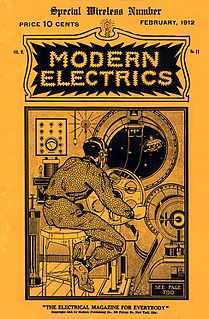 W
WHugo Gernsback was a Luxembourgish-American inventor, writer, editor, and magazine publisher, best known for publications including the first science fiction magazine. His contributions to the genre as publisher—although not as a writer—were so significant that, along with the novelists H. G. Wells and Jules Verne, he is sometimes called "The Father of Science Fiction". In his honour, annual awards presented at the World Science Fiction Convention are named the "Hugos".
 W
WAmazing Stories is an American science fiction magazine launched in April 1926 by Hugo Gernsback's Experimenter Publishing. It was the first magazine devoted solely to science fiction. Science fiction stories had made regular appearances in other magazines, including some published by Gernsback, but Amazing helped define and launch a new genre of pulp fiction.
 W
WAmazing Stories Quarterly was a U.S. science fiction pulp magazine that was published between 1928 and 1934. It was launched by Hugo Gernsback as a companion to his Amazing Stories, the first science fiction magazine, which had begun publishing in April 1926. Amazing Stories had been successful enough for Gernsback to try a single issue of an Amazing Stories Annual in 1927, which had sold well, and he decided to follow it up with a quarterly magazine. The first issue of Amazing Stories Quarterly was dated Winter 1928 and carried a reprint of the 1899 version of H.G. Wells' When the Sleeper Wakes. Gernsback's policy of running a novel in each issue was popular with his readership, though the choice of Wells' novel was less so. Over the next five issues, only one more reprint appeared: Gernsback's own novel Ralph 124C 41+, in the Winter 1929 issue. Gernsback went bankrupt in early 1929, and lost control of both Amazing Stories and Amazing Stories Quarterly; associate editor T. O'Conor Sloane then took over as editor. The magazine began to run into financial difficulties in 1932, and the schedule became irregular; the last issue was dated Fall 1934.
 W
WThe Electrical Experimenter was an American technical science magazine that was published monthly. It was established in May 1913, as the successor to Modern Electrics, a combination of a magazine and mail-order catalog that had been published by Hugo Gernsback starting in 1908. The Electrical Experimenter continued from May 1913 to July 1920 under that name, focusing on scientific articles about radio, and continued with a broader focus as Science and Invention until August 1931.
 W
WExperimenter Publishing was an American media company founded by Hugo Gernsback in 1915. The first magazine was The Electrical Experimenter (1913–1931) and the most notable magazines were Radio News (1919–1985) and Amazing Stories (1926–2005). Their radio station, WRNY, began broadcasting experimental television in 1928. In early 1929 the company was forced into bankruptcy and the Gernsback brothers lost control of Experimenter Publishing. The magazines did not miss an issue and were quickly sold to another publisher. The Gernsbacks promptly started new magazines to compete with their former ones.
 W
WA fandom is a subculture composed of fans characterized by a feeling of empathy and camaraderie with others who share a common interest. Fans typically are interested in even minor details of the objects of their fandom and spend a significant portion of their time and energy involved with their interest, often as a part of a social network with particular practices ; this is what differentiates "fannish" (fandom-affiliated) fans from those with only a casual interest.
 W
WModern Electrics was a technical magazine for the amateur radio experimenter. The magazine existed between 1908 and 1914.
 W
WRalph 124C 41 +, by Hugo Gernsback, is an early science fiction novel, written as a twelve-part serial in Modern Electrics magazine, which Gernsback edited, beginning in April 1911. It was compiled into novel/book form in 1925. While it pioneered many ideas found in later science fiction, it has been critically panned for its "inept writing". The title itself is a play on words, meaning "One to foresee for one another". In the introduction to the first volume of Science-Fiction Plus, dated March 1953, Gernsback called for patent reform to give science fiction authors the right to create patents for ideas without having patent models because many of their ideas predated the technical progress needed to develop specifications for their ideas. The introduction referenced the numerous prescient technologies described throughout Ralph 124C 41+.
 W
WScientific Detective Monthly was a pulp magazine that published fifteen issues beginning in January 1930. It was launched by Hugo Gernsback as part of his second venture into science-fiction magazine publishing, and was intended to focus on detective and mystery stories with a scientific element. Many of the stories involved contemporary science without any imaginative elements—for example, a story in the first issue turned on the use of a bolometer to detect a black girl blushing—but there were also one or two science fiction stories in every issue.
 W
WWonder Stories was an early American science fiction magazine which was published under several titles from 1929 to 1955. It was founded by Hugo Gernsback in 1929 after he had lost control of his first science fiction magazine, Amazing Stories, when his media company Experimenter Publishing went bankrupt. Within a few months of the bankruptcy, Gernsback launched three new magazines: Air Wonder Stories, Science Wonder Stories, and Science Wonder Quarterly.